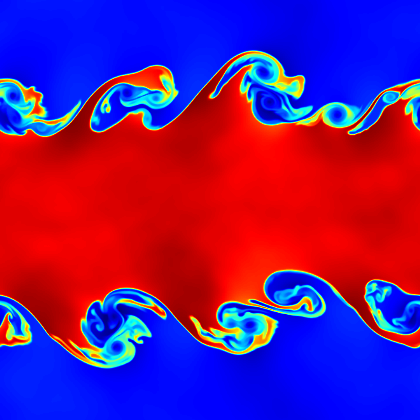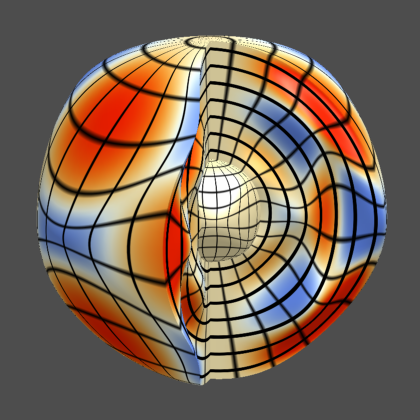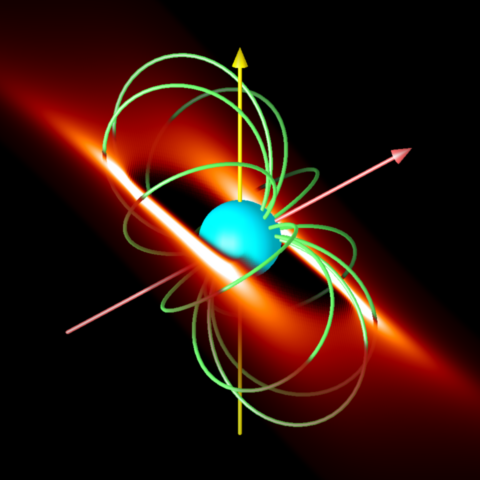A brace of new papers...
Feb 15 2010, 12:10
Over the past month, two papers I'm involved in have been accepted for publication. The first comes from work with Bryan Gaensler, Lisa Harvey-Smith and collaborators at the Sydney Institute for Astronomy, and deals with the Faraday rotation signatures of magnetized supernova remnants (see here for a brief glance at some of the MHD simulations related to the project). The idea is to explain the puzzling magnetic field geometry around the remnant G296.5+10.0; the paper argues that this geometry could result from a supernova explosion into a pre-existing magnetized wind.
The second paper also concerns magnetic fields, but in a very different context. Ellen Zweibel and Daniel Lecoanet have discovered that in some circumstances a magnetic field parallel to a shear flow in a stratified medium can destabilize the flow, even if the Richardson criterion suggests that the flow should be stable against the Kelvin-Helmholtz instability. My contribution to the project was a large set of computations mapping out the regions of parameter space inhabited by the new-found instability. It's possible that the instability may contribute toward mixing and angular momentum transport in stars.
Poly-Web: A web-based polytrope calculator
Nov 18 2009, 09:36
To help the students in my course develop better insights into simple stellar models, I've created a web-based code that constructs polytropes by solving the Lane-Emden equation for arbitrary polytropic index n. This Poly-Web tool provides a useful companion to EZ-Web, my web-based stellar evolution code.
Mad Star now has caching
Oct 13 2009, 12:43
To address concerns I've had over the time taken to load pages on mad star (esp. the EZ-Web page, which has large tables), I've spent the morning implementing caching in the parsing engine. It all seems to work OK, and the speed-up was well worth the effort. But I really should do some science sometime...
I'm hiring a new Post-Doc
Oct 9 2009, 15:51
Over the coming year I'll be hiring a Post-Doctoral Research Assistant, to form the core of the team for my NSF project modeling wave transport of angular momentum. Full details will be appearing in the November 2009 issue of the AAS Job Register, but here is the general description:
The Department of Astronomy at the University of Wisconsin, Madison is
advertising a postdoctoral position in stellar astrophysics. The
successful applicant will work with Prof. Richard Townsend in
developing models for the impact of pulsational instabilities on the
evolution of massive, luminous stars. This project will make extensive
use of high-performance computer facilities available to the
Department, and prior experience with programming in parallel
environments will be looked upon favorably. The position is initially
for two years with an optional third year. The nominal starting date
is no later than September 1 2010.
Applicants must have a recent Ph.D. in astronomy or a related
field. Applications should include a summary of research interests, a
bibliography, a curriculum vitae, and three letters of recommendation
sent to the address below. Applications received by December 31 2009
will be ensured full consideration. Application materials should be
sent to Prof. Richard Townsend, Department of Astronomy, University of
Wisconsin-Madison, 4402 Sterling Hall, 475 N Charter St., Madison, WI
53706, USA. E-mail inquiries should be directed to townsend AT astro.wisc.edu.
Interested applicants needn't wait until the advert appears in the Job Register; I'm accepting applications right now.
New paper: 'Discovery of a magnetic field in the O9 sub-giant star HD 57682 by the MiMeS Collaboration'
Oct 1 2009, 23:27
This letter, just been accepted for publication in Monthly Notices of the RAS, reports the discovery of a ~1.6 kG dipole magnetic field in HD 57682. The detection was made using the ESPaDOnS spectropolarimeter mounted on the Canada-France-Hawaii Telescope. The observations comprise part of MiMeS (Magnetism in Massive Stars) project that I'm involved in, one of the Large Programs currently being undertaken on the CFHT.
Personally, I can take very little credit for the paper — it's thanks to Jason Grunhut and the other observers that we obtained this great detection. But of course, I'm excited by the prospects for furthering our theoretical understanding of magnetism in massive stars; we now know of fields in four O-type stars, indicating that they are not so rare as once believed.



